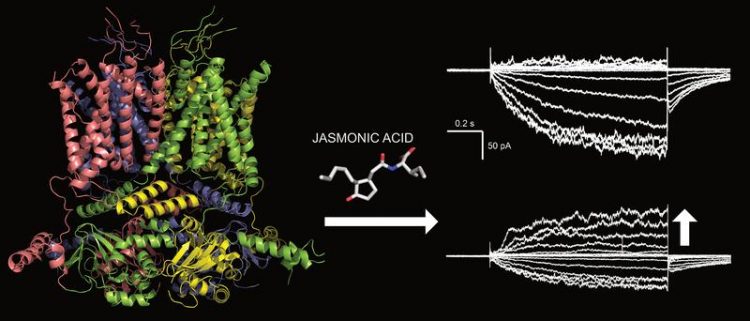News About a Plant Hormone

3d-Model of the potassium ion channel GORK of Arabidopsis thaliana. Wounding of the plant triggers the activation of the jasmonate signaling pathway and results in the activation of GORK. Picture: Dirk Becker
Jasmonic acid is not just the aromatic odor of the plant Jasminum grandiflorum used in cosmetics and perfume industries. Plants wounded by e.g. chewing herbivores produce jasmonic acid as a defense signal, as a phytohormone to mount their defense responses – this includes for example the formation of toxic substances. They even employ volatile derivatives of jasmonic acid to warn their neighbors to fight the rising threat in time.
Today, an international research team led by the plant biologist Dirk Becker of Julius-Maximilians-Universität Würzburg (JMU) in Bavaria, Germany, report on their novel findings on jasmonic acid effects in the renowned scientific journal Developmental Cell. They found that jasmonic acid also is involved in the quick closure of stomata.
Wounding induces the closure of stomata via jasmonic acid
Stomata are adjustable pores formed by two guard cells in the epidermis of plant leaves. They control the uptake of carbon dioxide crucial for photosynthesis and at the same time the plants’ water balance. The phytohormone abscisic acid (ABA) represents a key signal for stomatal closure. Plants produce ABA during drought stress to save water.
During their experiments on guard cell volume control by biotic stress the team from the JMU Chair of Plantphysiology and Biophysics noticed that mechanical wounding of leaves of the model plant Arabidopsis thaliana quickly triggers stomatal closure, too. Surprisingly, this effect was not restricted to the wounded leaf, but also occurred in neighboring leaves.
“This observation was not reported before and suggested to us that the jasmonate signaling pathway might have been turned-on in the guard cells,” explains Dirk Becker. But how to monitor jasmonic acid signaling in guard cells? Here the Würzburg team received assistance from the plant biologist Antoine Larrieu (Ecole Normale Supérieure Lyon), who had developed a genetically encoded fluorescent sensor for monitoring jasmonate signaling in living cells. He could show that wounding indeed activates the jasmonic acid signaling cascade in guard cells.
From jasmonic acid to a potassium channel
Stomatal closure requires the efflux of anions and potassium mediated by guard cell ion channels. To understand the molecular mechanism that underlie jasmonic acid controlled stomatal closure the Becker team went out searching for mutants that would not respond to jasmonate treatment.
When screening their mutant collection of guard cell ion channels they discovered the K+ channel (GORK) as an essential target of jasmonate induced stomatal closure. In collaboration with the labs from Jörg Kudla (Universität Münster) and Erwin Grill (Technische Universität München) they could identify a calcium dependent protein kinase – the plant specific CBL/CIPK complex – to interact and regulate the activity of the GORK potassium channel. “Wounding induces calcium signals in guard cells and in electrophysiological studies we could demonstrate that the calcium-binding CBL1/CIPK5 complex activates the ion channel”, Dirk Becker states.
Two plant hormones in a molecular crosstalk
The research team further identified the protein phosphatase ABI2 to counteract kinase mediated channel activation, thus representing a negative regulator of jasmonate signaling in guard cells. Becker further explains, “Interestingly, ABI2 is the co-receptor for the plant drought hormone ABA. This is indicating molecular crosstalk between the two phytohormones jasmonic acid and abscisic acid.” Indeed, together with colleagues from the Pedro Rodriguez lab (Universitat Politecnica Valencia) the team could show that Arabidopsis mutants lacking guard cell ABA receptors are also insensitive to jasmonic acid.
With their story the international team of plant biologists led by JMU scientist Dirk Becker has made an important step in understanding the molecular framework that allows plants to respond to wounding stress in guard cells. Leaf turgor and photosynthetic rates correlate with stomatal conductance.
Thus, wounding induced stomatal closure might provide an emergency signal to plants. “Currently we do not know how jasmonic acid addresses the abscisic acid signaling pathway”, Becker says. The Würzburg team now will investigate whether jasmonic acid triggers abscisic acid biosynthesis or whether it acts at the level of abscisic acid perception and sensitivity.
Puzzling observation about Coronatine
Plant pathogenic Pseudomonas bacteria are capable of producing a molecular mimicry of jasmonic acid, known as Coronatine. Plant physiologists commonly use Coronatine as a substitute for jasmonic acid in their experiments.
“In the long term, however”, Becker explains, “Coronatine does just the opposite of jasmonic acid in guard cells: it opens stomata providing an entry pathway for the pathogenic bacteria.” This puzzling observation shall be resolved in future studies by comparing differentially expressed genes in guard cells after jasmonic acid or coronatine treatment.
Prof. Dr. Dirk Becker, Chair of Molecular Plantphysiology and Biophysics – Botany I, University of Würzburg, T +49 931 31-86108, dbecker@botanik.uni-wuerzburg.de
Wounding Induced Stomatal Closure Requires Jasmonate-Mediated Activation of GORK K+ Channels by a Ca2+ Sensor-Kinase CBL1-CIPK5 Complex. Developmental Cell, 6 December 2018, DOI: 10.1016/j.devcel.2018.11.014
Media Contact
More Information:
http://www.uni-wuerzburg.deAll latest news from the category: Life Sciences and Chemistry
Articles and reports from the Life Sciences and chemistry area deal with applied and basic research into modern biology, chemistry and human medicine.
Valuable information can be found on a range of life sciences fields including bacteriology, biochemistry, bionics, bioinformatics, biophysics, biotechnology, genetics, geobotany, human biology, marine biology, microbiology, molecular biology, cellular biology, zoology, bioinorganic chemistry, microchemistry and environmental chemistry.
Newest articles

Properties of new materials for microchips
… can now be measured well. Reseachers of Delft University of Technology demonstrated measuring performance properties of ultrathin silicon membranes. Making ever smaller and more powerful chips requires new ultrathin…

Floating solar’s potential
… to support sustainable development by addressing climate, water, and energy goals holistically. A new study published this week in Nature Energy raises the potential for floating solar photovoltaics (FPV)…

Skyrmions move at record speeds
… a step towards the computing of the future. An international research team led by scientists from the CNRS1 has discovered that the magnetic nanobubbles2 known as skyrmions can be…





















